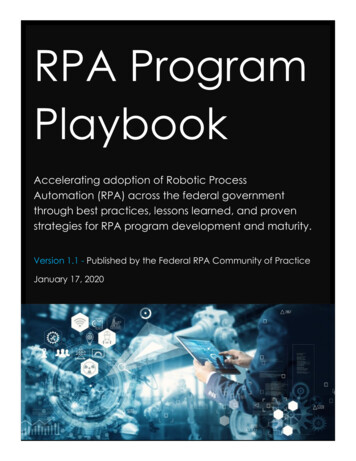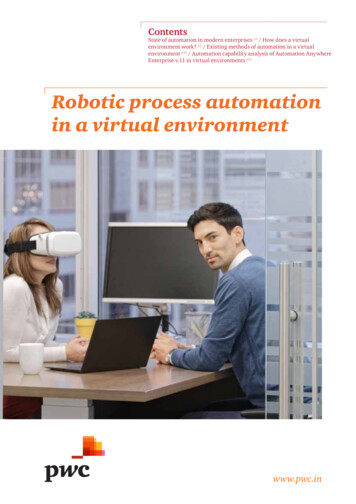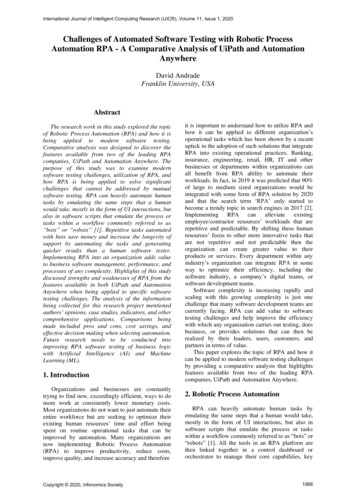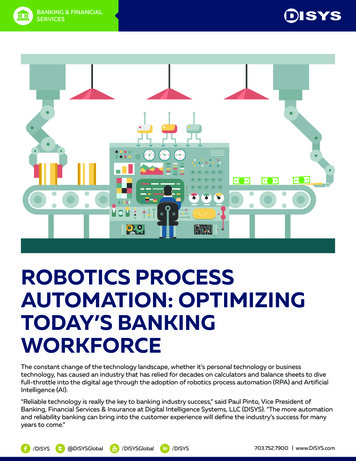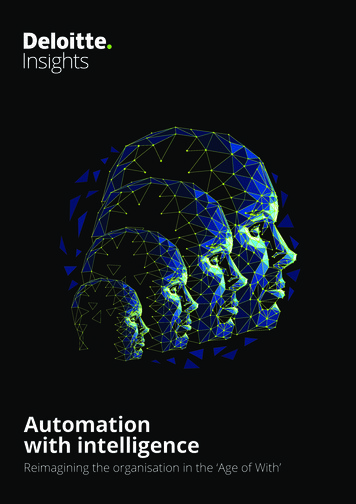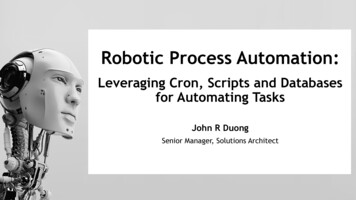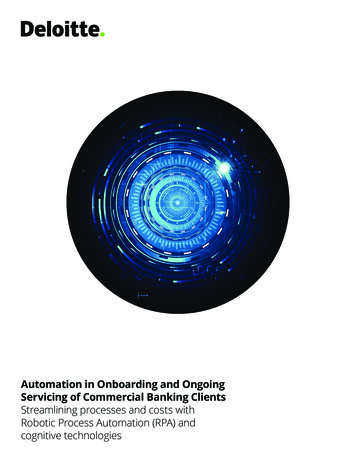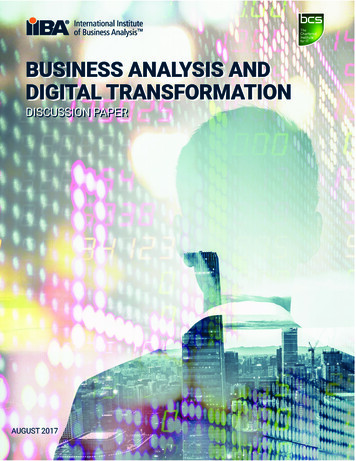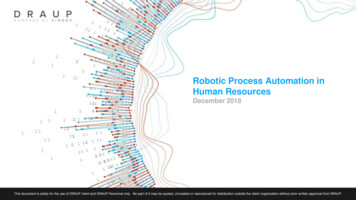
Transcription
Robotic process automation (RPA)The next revolution of Corporate Functions
Table of ContentsRPA compared to Traditional Automation4Capgemini feedback on RPA implementation5Corporate functions eligible to RPA63 benefits to RPA 6 Improved employee and customer satisfaction Accelerated productivity gains Enhanced complianceRPA implementation roadmap 102
More than ever, Technology reached a tipping point inthe optimization of Corporate Functions.Similar to robotization of production lines in the 90’s, CorporateFunctions are initiating today their robotic transformation/revolution.We believe Robotic Process Automation or RPA is the leverthat will take these Corporate Functions to the next level by: Improving employee and customer satisfaction Accelerating productivity gains Enhancing complianceTo reach these benefits, RPA must be implemented on keyCorporate Functions that include repetitive, standardizedand transactional processes and activities such as Finance,Compliance, Treasury and Marketing.Within these Corporate Functions, not all processes andactivities are eligible to RPA though, hence the need to selectthem carefully in order to reap the maximum benefit fromRPA implementation.An additional RPA key success factor consists of paying aparticular attention to design an appropriate implementationjourney sticking to company specifics.403
What is RPA compared toTraditional Automation?Artificial Intelligence or AI isthe intelligence machines arecapable of. AI technologieshave 3 major capabilities:RPA AITraditional AutomationToolsInterfaceToolsInterface1. Capture informationthrough vision and soundrecognition, search ordata analysis2. Leverage algorithmsand machine learningto provide inputs forinterpretation of data3. Make appropriatedecisions and executethem automaticallyActivities are performed byHumans, helped by technologyTools are used to perform tasksEmployees bridge the gap betweenautomated string of tasksWithout human intervention,end-to-end processes can not becarried out autonomouslyIllustrationMacro tasks inExcel SpreadsheetsE-mails notificationsERP transactions4Move databetween screensComplete onlineforms, PDFsCopy and pasteClose and rekeyinto applicationsActivities are “outsourced”to RobotsEnd-to-end processes are carried-outby the robotRobots connect existing tools and theemployee handles only exceptionsCognitive technologies, based onartificial intelligence expand RPApossibilities and help reach the nextlevel of performanceIllustrationMacro tasks inExcel SpreadsheetsMove databetween screensComplete onlineforms, PDFsE-mails notificationsNo manualcopy and pasteERP transactionsClose and rekeyinto applications
Capgemini feedback onRPA implementationTechnology SelectionIn 2014, Capgemini launched its internal RPA program. Dr. Marcus Esser describesthe approach as follows: “We tested 6 leading RPA technologies and compared theircapacity to perform simple tasks, such as identifying a company logo, extractingdata. Finally, we decided to partner with Ui Path, based on criteria such as thepossibility to program remotely and to deploy the robot without developing interfaceswith existing applications”.ROICapgeminiin-house robotshave processedSo far, we have automated 200 processes on 50 robots in our delivery centersworldwide, with a positive return on investment within a few months, dividingrunning costs by 7.1,5Milliontransactions since2015, equivalent to200 employees“Process designis more relevant tothe ROI than thetechnology used”Phase 3Phase 2Phase 1Desktop automation2014Cognitive input recognition2016Self-scripting Robots20182020Lessons learnt“One of the main lessons we learnt”, says Dr. Esser, “is that results vary widely fromone process to another, depending on their design”. The best results are obtainedwith activities which can be run in batch mode, don’t require human decisionmaking during the process and already include elements of automation. The costreduction in these cases can exceed 80%.The most recent improvement was to reduce human input to feed structured datato the robot. Capgemini hybrid RPA solution combines Robotics with Cognitivesoftware, to structure the input and increase robots level of autonomy.Capgemini wants to reduce the implementation cost for new robots, by reducingthe time developers need to program the processes. Within 3 years, Capgeminiwill replace manual scripting by “intelligent sensors”, which record tasks on a workstation and interpret the patterns to auto-script the robots program.5
Corporate functionseligible to RPAFunctionsExamples of activitiesFinanceData cleaningOrder managementCompliancePayment processingCompliance reportingautomationTreasuryClaims handlingUnderwriting in bankingMarketingDirect DebitAutomated marketingcampaigns3 benefits RPA bringsto Corporate functionsImproved employee andcustomer satisfactionAccelerated productivity gainsEnhanced compliance 1 robot replaces on average 4 FTEs Robot costs are on average50% - 90% lower than off-shore /on-shore employeesTraceability reduces risk of errorsand secures consistency Automated Control steps increasecompliance Systematic documentation of audittrailTedious repetitive tasks aredelegated to robots Time generated to focus oncustomer care Empowered employees to performmore value-added tasksDelivery Excellence6 Quick development cycles,providing ROI in 3-6 monthsAcceleration of ROICompliance to evergrowing regulation
Improved employee and customer satisfactionRPA gives employees time on more intellectually stimulating activities, since tediousrepetitive tasks are delegated to robots (example: formatting or copy pasting datafiles).The robot can execute rule-based tasks, leaving employees with time to work onvalue-added tasks requiring judgement and soft skills, such as advising customers.Illustration of a “robotized” processBack office workersspend up to80%of their time onrepetitive manual tasks,lowering performanceand motivation.XAgent entersorder inrobot queueRobot X imports datafrom differentsystemsGets customer quoteAgent reviews dataRobot Y writesprocess, createsquote, and confirmsor cancels orderAgent handlesexceptionException rulesapply?YesNoUpdate systemEndA recent field study shows that in many businesses “robots are welcomed asvaluable team members because they do the work that humans don’t want to do”1Feedback from early RPA adopters is positive, as employees see robots asassistants and feel that the company is empowering them to spend time on moresatisfying work.1. Study of the impact of RPA on the work environment, Professors Leslie Willcocks and Mary Lacity fromthe London School of Economics7
Accelerated Productivity GainsWhen it comes to back office operations in Corporate Functions, a continuouslypursued objective is productivity improvement. RPA provides a new productivitylever, on top of Lean initiatives and off-shoring.Robots allow an easier labor arbitrage (see box below). They can therefore be usedto replace employees, as they replicate human actions on a desktop interface.“Sourcing cost for Back-offices40,000 Robotic Automationtools are up to 65%less expensive thanoffshore-based fulltime employees1”5,000 Robot10,000 Off-shoreemployee*On-shoreemployee**Average annual gross cost in common shared services centers locationsRobots are also more productive, as they work non-stop. They have 260 thousandworking hours per year, compared to 32 thousand of an office clerk. This is 8 timesmore.In, addition Robot implementation has a quicker return on investment than classicautomation, as programming and setting-up of RPA for individual processes canbe accomplished within few weeks without impacting the existing IT infrastructure.Typically, the ROI is 3-6 months, but can vary widely depending on the processdesign and process environment. Picking the right target is crucial.Example of a process robotized in a British bankBefore RobotizationImplementation phaseAfter Robotization3 FTE for 8 weeksEvery transaction lastsabout 30 minutesRepetitive tasks aredelegated to robotsProject team mustinclude a Roboticdeveloper to mapthe processes andprogram the robotTransaction time(human) reduced to10 minutesROI of 80% achievedwithin 6 monthsIt is thus no surprise that the RPA market grows at a fast pace, doublingevery 6 months and bound to reach 5 Billion USD by 20202.1. Everest Group’s Finance and Accounting Outsourcing Annual Report 20142. Transparency Market Research.8
Enhanced complianceIn industries with constraining regulations, RPA provides a lever to manageincreasing requirements for two reasons.Firstly, transactions are recorded and steps are systematically applied, whichprevent manual errors and provide full transparency to auditors.Secondly, Risk and Compliance departments can use robots themselvesto execute reconciliations and automate daily routine controls reducing theworkload generated by routine tasks (see box below).Case studyAs the requirementsfrom regulatorscontinue toincrease, companieswill rely more onrobot workforce toface this challenge“Automated control”Recently, a British bank had to deal with a steep increase in highrisk accounts and has turned to RPA to manage the associatedworkload. Every day, they mobilized 11 employees for 8 hoursto control these accounts. The bank fully automated this activityprogramming 20 robot artefacts. The robotized cycle time wasreduced by half to 4 hours.As the technology evolves and robots become more autonomous, newquestions emerge, especially in relation with artificial intelligence. In a nearfuture robots will be able to program themselves and continue learning asthey work. If an error occurs, who will be to blame? These new risks meanthat companies deploying RPA have to define a clear governance and thinkof the impacts that robotization will have on their organization.9
A successful RPA implementationshould follow a predefined journey3Choose the appropriate RPA solutionChoose whether you should:1. Build your own in-house solution2. Buy a market solution with a proventrack-record2Build you KPIs for productivityimprovement trackingOptimize existing processesSeek performance improvement areaswithin processes having RPA potentialRPA suitabilityCost ofimplementationReturn on investmentUnfavorableRule tandardizedManyexceptionsStable overtimeFrequentchangesFrequenterrorsRarely dicactivityFor a better zoomedview, go to page 1210Adaptation to ITlandscapeProgramming Effort243232444For a better zoomedview, go to page 12Get rid of redundancies and processinefficiencies beforehand RPAimplementationFavorableRobot Accuracy1Define RPA perimeterIdentify RPA eligible processes and activitiesTell for each process whether it:1. Is Ready for RPA2. Has have not any robot automation potential3. Has have RPA potential, but have to be adjusted first
5Study impacts on the Target Operating ModelSet up an appropriate governance4Associate first users, IT,Compliance, Security and HRTo secure sustainabilityReview your competency modelDefine the requiredspan of controlMap the target organizationThe desired relationshipbetween your virtual and humanworkforceUse ProcessReengineering orLean to makethem fit for RPADefine roles andresponsibilitiesand governanceStudy impacts on processes not in thescope of RPA but that might be affectedOperatingModelimpactsBuild technical RPAcapacities to maintainthe robot fleetIdentify dependencieswith existinginformation systemDefine a competencymodel focused oncomplementary skills(people orientation)For a better zoomedview, go to page 13Define the “man to machineratio” you deem appropriateRPADeployment6Build a deployment planningPlan programming or solution integrationPlan change management actionsIdentify potential risks and build a risk mitigation planning11
Zooms on RPA implementation journeyReturn on investmentCost ofimplementationRPA suitability1. Define RPA perimeter: Process assessmentFavorableUnfavorableRule tandardizedManyexceptionsStable overtimeFrequentchangesFrequenterrorsRarely dicactivity3. Select RPA solution12Robot AccuracyAdaptation to ITlandscapeProgramming Effort243232444
5. Impacts on the Target Operating ModelDefine roles,responsibilitiesand governanceAssociate first users,IT, Compliance,Security and HRto securesustainabilityUse processreengineeringmethodologies to fityour processes toRPA requirementsOperatingModelimpactsBuild technical RPAcapacities to maintainthe robot fleetIdentify dependencieswith existinginformation systemDefine a competencymodel focused oncomplementary skills(people orientation)13
14
15
Capgemini Consulting contactsFranceGermanyBelgiumCédric BERTHELOTVolker DariusRobert van der GermanyBelgiumMartin KARACAWolfgang EndersSanjay yLatin AmericaChristian KROLLTorsten BAUMBACHMartin h@capgemini.commartin.romero@capgemini.comAbout CapgeminiCapgemini Consulting is the global strategy and transformationconsulting organization of the Capgemini Group, specializingin advising and supporting enterprises in significanttransformation, from innovative strategy to execution andwith an unstinting focus on results. With the new digitaleconomy creating significant disruptions and opportunities,the global team of over 3,000 talented individuals workwith leading companies and governments to master DigitalTransformation, drawing on their understanding of the digitaleconomy and leadership in business transformation andorganizational change.Find out more at: www.capgemini-consulting.comWith more than 180,000 people in over 40 countries, Capgeminiis a global leader in consulting, technology and outsourcingservices. The Group reported 2015 global revenues of EUR11.9 billion. Together with its clients, Capgemini createsand delivers business, technology and digital solutionsthat fit their needs, enabling them to achieve innovationand competitiveness. A deeply multicultural organization,Capgemini has developed its own way of working, theCollaborative Business ExperienceTM, and draws onRightshore , its worldwide delivery model.Learn more about us at www.capgemini.comRightshore is a trademark belonging to CapgeminiCapgemini Consulting is the strategy and transformation consulting brand of Capgemini Group. The information contained in this document is proprietary. 2016 Capgemini. All rights reserved.
making during the process and already include elements of automation. The cost reduction in these cases can exceed 80%. The most recent improvement was to reduce human input to feed structured data to the robot. Capgemini hybrid RPA solution combines Robotics with Cognitive software, to s
